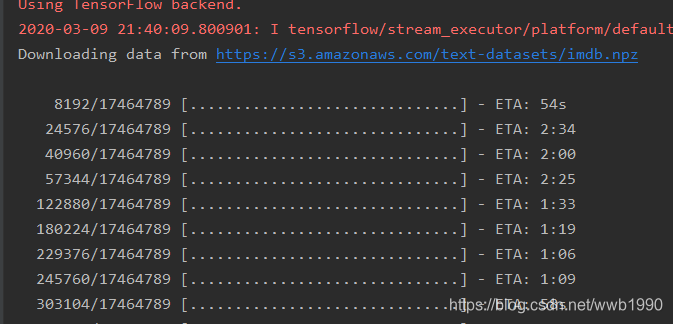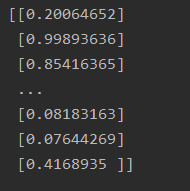IMDB数据集
互联网电影数据,包含50000条严重两极分化的评论。正面和负面评论各占50%。
而该数据集也同样被内置于Keras库中了。
其中的评论数据已经经过了预处理,评论(单词)被转化为了整数序列,每个整数都对应词典里面的一个单词。
加载数据集
from keras.datasets import imdb
(train_data,train_labels),(test_data,test_labels) = imdb.load_data(num_words=10000)
#第一条评论的单词索引列表
print(train_data[0])
#1表示正面品论,0表示负面评论
print(train_labels[0])
#取所有测试单词所有的最大的索引值
print(max([max(sequence) for sequence in train_data]))
num_words=10000是取最常出现的10000个单词,舍弃低频词语。减小向量数据量。
train_data和test_data都是评论的列表(单词索引组成)。
train_labels和test_labels都是0和1组成的列表。
 可以看到最大9999就是说索引不超过10000
可以看到最大9999就是说索引不超过10000
第一次加载时会下载数据集

解码为英语
#某条评论解码为英文
word_index = imdb.get_word_index()
reverse_word_index = dict(
[(value,key) for (key,value) in word_index.items()]
)
decoded_review = ' '.join(
[reverse_word_index.get(i-3,'?') for i in train_data[0]]
)
print(decoded_review)
imdb.get_word_index()这个是单词映射整数的字典,将其键值颠倒,变为根据索引查单词。
其中i-3是因为0,1,2是为填充,序列开始,未知词保留的索引

处理数据
import numpy as np
#转换为10000维的向量,索引的位置是1,其他位置是0
def vectorize_sequences(sequences,dimension=10000):
results = np.zeros((len(sequences),dimension))
for i, sequence in enumerate(sequences):
results[i,sequence] = 1.
return results
#数据向量化
x_train = vectorize_sequences(train_data)
x_test = vectorize_sequences(test_data)
print(x_train[0])
#标签向量化
y_train = np.asarray(train_labels).astype('float32')
y_test = np.asarray(test_labels).astype('float32')
将每一条评论的索引值转化到10000维向量上。有该索引值的设为1,其余位置设为0.
例如一条评论为[1,3,5],则变为[0,1,0,1,0,1,0,0,0,0…,0]。

建立网络
from keras import models
from keras import layers
#模型定义
model = models.Sequential()
model.add(layers.Dense(16,activation='relu',input_shape=(10000,)))
model.add(layers.Dense(16,activation='relu'))
model.add(layers.Dense(1,activation='sigmoid'))
#定义优化器,损失函数,指标
model.compile(optimizer='rmsprop',
loss='binary_crossentropy',
metrics=['accuracy'])
模型为三层。
- 一二层都是16个隐藏单元,输入10000维的向量。做的操作除了张量的操作外,relu是激活函数之一,将线性的变换集合变成非线性。
- 第三层输出1维,sigmod是将输出归一化,变成[0,1]的概率。
二分类问题,输出是一个概率值(正面评价的概率)。
因此选用交叉熵(crossentropy)来计算损失。
而优化器使用rmsprop。这是前任总结的最优于此示例的,至于为什么选这两个,后面章节在做学习。
验证集
为了在训练过程中监控模型对于未见过的数据上的精度,从数据中去出10000个样本用来做验证集。
#取10000用于验证集
x_val = x_train[:10000] #验证集
partial_x_train = x_train[10000:]
y_val = y_train[:10000] #验证集
partial_y_trail = y_train[10000:]
训练模型
#训练模型
history = model.fit(partial_x_train,
partial_y_trail,
epochs=20,
batch_size=512,
validation_data=(x_val,y_val))
history_dict = history.history
print(history_dict.keys())
我们输入训练数据集partial_x_train,训练标签集partial_y_trail。
全部数据训练次数*20。
一次取512的个数据。
history 中包含了训练过程中的所有数据。
validation_data是前一步取出来的验证集。
history包含训练过程中的所有数据。打印history_dict所包含的指标。

可以看到其中包括验证精度,训练精度,验证损失,训练损失。
我们来用matplot绘制出这几个指标的走势:
损失变化图:
loss_values = history_dict['loss']
val_loss_values = history_dict['val_loss']
epochs = range(1,len(loss_values)+1)
plt.plot(epochs,loss_values,'bo',label='Training loss') #bo是蓝色圆点
plt.plot(epochs,val_loss_values,'b',label='Validation loss') #b是蓝色实线
plt.title('Training and validation loss')
plt.xlabel('Epochs')
plt.ylabel('Loss')
plt.legend()
plt.show()
精度变化图:
plt.clf() #清空图表
acc_values = history_dict['acc']
val_acc_values = history_dict['val_acc']
plt.plot(epochs,acc_values,'bo',label='Training acc') #bo是蓝色圆点
plt.plot(epochs,val_acc_values,'b',label='Validation acc') #b是蓝色实线
plt.title('Training and validation accuracy')
plt.xlabel('Epochs')
plt.ylabel('Accuracy')
plt.legend()
plt.show()

 可以看出训练损失持续降低,训练精度持续增长。这满足梯度下降的优化预期。
可以看出训练损失持续降低,训练精度持续增长。这满足梯度下降的优化预期。
但是可以看到验证损失和验证精度,可以从图中看到,他们在第三到第四个周期达到了最佳。
总之,在训练数据上表现变好,但是在没有见过的验证数据上表现有变动。这就是过拟合(overfit)。
在第2轮后,对训练数据过度优化,最终学得的结果仅针对训练数据。无法泛华到训练集之外的数据。
就需要一种降低过拟合的方案。在后面的章节再来学习。
这里先用一种粗糙简单的方案。
我们只训练四轮。
修改训练参数epochs=4
#训练模型
history = model.fit(partial_x_train,
partial_y_trail,
epochs=4,
batch_size=512,
validation_data=(x_val,y_val))
在调用 fit() 训练之后添加测试集的测试代码,并输出结果:
result = model.evaluate(x_test,y_test)
print(result)

可见这种粗略的策略达到88%的精度。后面再来研究更好的降低过拟合,多做训练的策略。
训练好的网络,使用predict来对评论进行正面的可能性做预测。
predictResult = model.predict(x_test)
print(predictResult)

可以看到有非常确定的(>0.99或者<0.01),也有不确信的(0.4~0.6)。
这一节学习就到这。之后可以自行尝试
1.使用1层或者3层隐藏层
2.隐藏单元换成32或者64个
3.用损失函数mse
4.用激活函数tanh
整合上面全部代码:(epochs次数自行修改)
from keras.datasets import imdb
import numpy as np
from keras import models
from keras import layers
import matplotlib.pyplot as plt
(train_data,train_labels),(test_data,test_labels) = imdb.load_data(num_words=10000)
# #第一条评论的单词索引列表
# print(train_data[0])
# #1表示正面品论,0表示负面评论
# print(train_labels[0])
# #取所有测试单词所有的最大的索引值
# print(max([max(sequence) for sequence in train_data]))
# #某条评论解码为英文
# word_index = imdb.get_word_index()
# reverse_word_index = dict(
# [(value,key) for (key,value) in word_index.items()]
# )
# decoded_review = ' '.join(
# [reverse_word_index.get(i-3,'?') for i in train_data[0]]
# )
# print(decoded_review)
#转换为10000维的向量,索引的位置是1,其他位置是0
def vectorize_sequences(sequences,dimension=10000):
results = np.zeros((len(sequences),dimension))
for i, sequence in enumerate(sequences):
results[i,sequence] = 1.
return results
#数据向量化
x_train = vectorize_sequences(train_data)
x_test = vectorize_sequences(test_data)
print(x_train[0])
#标签向量化
y_train = np.asarray(train_labels).astype('float32')
y_test = np.asarray(test_labels).astype('float32')
#模型定义
model = models.Sequential()
model.add(layers.Dense(16,activation='relu',input_shape=(10000,)))
model.add(layers.Dense(16,activation='relu'))
model.add(layers.Dense(1,activation='sigmoid'))
#定义优化器,损失函数,指标
model.compile(optimizer='rmsprop',
loss='binary_crossentropy',
metrics=['accuracy'])
#取10000用于验证集
x_val = x_train[:10000] #验证集
partial_x_train = x_train[10000:]
y_val = y_train[:10000] #验证集
partial_y_trail = y_train[10000:]
#训练模型
history = model.fit(partial_x_train,
partial_y_trail,
epochs=4,
batch_size=512,
validation_data=(x_val,y_val))
history_dict = history.history
print(history_dict.keys())
loss_values = history_dict['loss']
val_loss_values = history_dict['val_loss']
epochs = range(1,len(loss_values)+1)
plt.plot(epochs,loss_values,'bo',label='Training loss') #bo是蓝色圆点
plt.plot(epochs,val_loss_values,'b',label='Validation loss') #b是蓝色实线
plt.title('Training and validation loss')
plt.xlabel('Epochs')
plt.ylabel('Loss')
plt.legend()
plt.show()
plt.clf() #清空图表
acc_values = history_dict['accuracy']
val_acc_values = history_dict['val_accuracy']
plt.plot(epochs,acc_values,'bo',label='Training acc') #bo是蓝色圆点
plt.plot(epochs,val_acc_values,'b',label='Validation acc') #b是蓝色实线
plt.title('Training and validation accuracy')
plt.xlabel('Epochs')
plt.ylabel('Accuracy')
plt.legend()
plt.show()
result = model.evaluate(x_test,y_test)
print(result)
predictResult = model.predict(x_test)
print(predictResult)